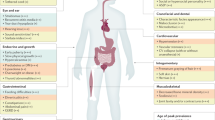Abstract
Certain behavioral and metabolic aspects of Turner syndrome (TS) are attributed to X-chromosome genomic imprinting. To investigate the possible contribution of imprinting to the physical features of the TS phenotype in live-born individuals, we genotyped the single normal X-chromosome in subjects with TS who all underwent a comprehensive evaluation as part of the NIH genotype–phenotype protocol. All had physical examinations, auxological measurements and imaging of the renal and cardiovascular systems. Absolute height and height as a percent of predicted height was the same in XM (n = 56) and XP (n = 23) subjects that had reached final height and were not growth hormone treated. Interestingly, adult height was significantly correlated with maternal but not paternal heights in both XM and XP groups. Neck webbing was found in 35% of the XM (n = 133) and 22% of the XP (n = 50) groups (P = 0.11). Renal anomalies were present in 24% of XM and 25% of XP groups (P = 0.9). Bicuspid aortic valve was found in 26% of XM and 24% of XP groups (P = 0.83), and any cardiovascular anomaly (abnormal aortic valve, aortic coarctation, elongated transverse aortic arch, anomalous pulmonary venous connection, left superior vena cava) affected 55% of XM and 52% of XP groups. Thus, we found no evidence for X-linked genomic imprinting effects on stature or lymphatic, renal or cardiovascular development in TS. Our sample size was sufficient to exclude such effects within 95% confidence limits. We did demonstrate a selective maternal effect on final stature that was independent of X-chromosome origin, suggesting potential autosomal imprinting effects on growth revealed by X monosomy.

Similar content being viewed by others
References
Bechtold SM, Dalla Pozza R, Becker A, Meidert A, Dohlemann C, Schwarz HP (2004) Partial anomalous pulmonary vein connection: an underestimated cardiovascular defect in Ullrich–Turner syndrome. Eur J Pediatr 163:158–162
Blaschke RJ, Rappold GA (2000) SHOX: growth, Leri-Weill and Turner syndromes. Trends Endocrinol Metab 11:227–230
Chu CE, Donaldson MD, Kelnar CJ, Smail PJ, Greene SA, Paterson WF, Connor JM (1994) Possible role of imprinting in the Turner phenotype. J Med Genet 31:840–842
Donnelly SL, Wolpert CM, Menold MM, Bass MP, Gilbert JR, Cuccaro ML, Delong GR, Pericak-Vance MA (2000) Female with autistic disorder and monosomy X (Turner syndrome): parent-of-origin effect of the X chromosome. Am J Med Genet 96:312–316
Gotzsche C, Krag-Olsen B (1994) Prevalence of cardiovascular malformations and association with karyotypes in Turner’s syndrome. Arch Dis Child 71:433–436
Hamelin CE, Anglin G, Quigley CA, Deal CL, on behalf of the Canadian Growth Hormone Advisory C (2006) Genomic imprinting in Turner syndrome: effects on response to growth hormone and on risk of sensorineural hearing loss. J Clin Endocrinol Metab 91:3002–3010
Ho V, Prince M (1998) Thoracic MR aortography: imaging techniques and strategies. Radiographics 18:287–309
Ho VB, Bakalov VK, Cooley M, Van PL, Hood MN, Burklow TR, Bondy CA (2004) Major vascular anomalies in turner syndrome: prevalence and magnetic resonance angiographic features. Circulation 110:1694–1700
Katia Delaval AWRF (2006) Epigenetic deregulation of imprinting in congenital diseases of aberrant growth. BioEssays 28:453–459
Li L, Manor O, Power C (2004) Early environment and child-to-adult growth trajectories in the 1958 British birth cohort. Am J Clin Nutr 80:185–192
Lippe B (1991) Turner syndrome. Endocrinol Metab Clin North Am 20:121–152
Loscalzo ML, Van PL, Ho VB, Bakalov VK, Rosing DR, Malone CA, Dietz HC, Bondy CA (2005) Association between fetal lymphedema and congenital cardiovascular defects in Turner syndrome. Pediatrics 115:732–735
Mathur A, Stekol L, Schatz D, MacLaren NK, Scott ML, Lippe B (1991) The parental origin of the single X chromosome in Turner syndrome: lack of correlation with parental age or clinical phenotype. Am J Hum Genet 48:682–686
Mazzanti L, Cacciari E (1998) Congenital heart disease in patients with Turner’s syndrome. Italian Study Group for Turner Syndrome (ISGTS). J Pediatr 133:688–693
Nielsen J, Wohlert M (1990) Sex chromosome abnormalities found among 34,910 newborn children: results from a 13-year incidence study in Arhus, Denmark. Birth Defects Orig Artic Ser 26:209–223
Prandstraller D, Mazzanti L, Picchio F, Magnani C, Bergamaschi R, Perri A, Tsingos E, Cacciari E (1999) Turner’s syndrome: cardiologic profile according to the different chromosomal patterns and long-term clinical follow-up of 136 nonpreselected patients. Pediatr Cardiol 20:108–112
Ross JL, Scott C Jr, Marttila P, Kowal K, Nass A, Papenhausen P, Abboudi J, Osterman L, Kushner H, Carter P, Ezaki M, Elder F, Wei F, Chen H, Zinn AR (2001) Phenotypes associated with SHOX deficiency. J Clin Endocrinol Metab 86:5674–5680
Salerno MC, Job JC (1987) Height in Turner’s syndrome: correlation with parents’ height. Arch Fr Pediatr 44:863–865
Skuse DH, James RS, Bishop DV, Coppin B, Dalton P, Aamodt-Leeper G, Bacarese-Hamilton M, Creswell C, McGurk R, Jacobs PA (1997) Evidence from Turner’s syndrome of an imprinted X-linked locus affecting cognitive function. Nature 387:705–708
Van PL, Bakalov VK, Zinn AR, Bondy CA (2006) Maternal X chromosome, visceral adiposity, and lipid profile. JAMA 295:1373–1374
Acknowledgments
We are grateful to the girls and women with TS who gave so much to our research. The intramural research program of NICHD supported this work. ARZ received extramural support from NINDS grants NS35554 and NS42777. None of the authors has any competing interests.
Author information
Authors and Affiliations
Corresponding author
Rights and permissions
About this article
Cite this article
Bondy, C.A., Matura, L.A., Wooten, N. et al. The physical phenotype of girls and women with Turner syndrome is not X-imprinted. Hum Genet 121, 469–474 (2007). https://doi.org/10.1007/s00439-007-0324-4
Received:
Accepted:
Published:
Issue Date:
DOI: https://doi.org/10.1007/s00439-007-0324-4




